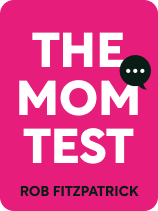

This article is an excerpt from the Shortform book guide to "The Mom Test" by Rob Fitzpatrick. Shortform has the world's best summaries and analyses of books you should be reading.
Like this article? Sign up for a free trial here.
What is the book The Mom Test about? What should you take away from Rob Fitzpatrick’s advice?
If you ask someone what they think of your business idea, they’ll almost always lie to your face to spare your feelings. However, Rob Fitzpatrick’s book The Mom Test says if you ask the right questions, you can strip away these lies and receive brutal honesty from anyone—even your mom.
Read below for an overview of The Mom Test.
The Mom Test by Rob Fitzpatrick
Rob Fitzpatrick’s The Mom Test book is a practical guide on how to get meaningful feedback about your business or product. Fitzpatrick explains how to ask the right questions and elicit unbiased responses from customers that will move your business forward. Although the book is intended primarily for entrepreneurs starting a new business venture from scratch, any business seeking to improve itself can take advantage of its principles.
Fitzpatrick was forced into a customer-facing role at his first company and struggled to gain much value from his conversations. He wrote The Mom Test to teach others what he wished he had known back then about how to most effectively talk to customers. Since its publication, The Mom Test has become a staple amongst professionals in the business world. It’s now used as a core part of the curricula at universities like Harvard, startup accelerators like Seedcamp, and businesses like Shopify.
What Is the Mom Test?
Fitzpatrick’s “Mom Test” is a set of rules that ensures you receive honest feedback from customers: specifically, feedback that signals whether your idea will meet their needs and therefore be successful. The test’s name originates from the idea that mothers in particular are most likely to lie to you to spare your feelings. However, if you ask the right questions, you can get honest, valuable feedback from whomever you ask—even your mom.
(Shortform note: Is it fair for Fitzpatrick to claim that parents are dishonest—and to name a set of rules (and a book) after this claim? Arguably yes: Studies suggest that parents regularly lie to their children. They do so not just to spare their children’s feelings but also to try to prevent tantrums, maintain traditional fantasies like the existence of Santa Claus, and avoid uncomfortable topics of conversation like death and sex.)
As Fitzpatrick explains, applying the Mom Test is important because customer feedback can make or break your new business venture. Deep one-on-one conversations with potential customers can give you all the information you need to craft a successful business. However, if you fail to collect or accurately interpret honest customer feedback, you could spend months or even years pouring money into a product with irredeemable flaws—or that customers never wanted in the first place. Furthermore, failing to use the Mom Test in your discussions with customers will yield information that’s worse than useless—as we’ll see, most feedback actively pushes you toward failure by convincing you that bad ideas are good.
(Shortform note: In Principles, Ray Dalio also argues that in business, you need to actively work to get others to tell you the truth so you can avoid investing in bad ideas. Unlike Fitzpatrick, Dalio primarily applies this idea to relationships between employees rather than relationships with customers. At the hedge fund he founded, Dalio has implemented a rule of radical honesty: All employees must speak up when they disagree with anyone else, even their boss’s boss. This way, everyone at the company receives brutal but useful feedback when they propose a bad idea.)
Fitzpatrick’s Mom Test consists of three rules:
- Rule #1: Don’t pitch your idea.
- Rule #2: Ask specific questions about the past.
- Rule #3: Listen more than you talk.
(Shortform note: Although Fitzpatrick frames the Mom Test as a set of three rules, in practice, they combine to form a single mindset. In other words, following one rule at a time would be missing the point—they’re all part of a greater whole and should thus be applied concurrently.)
Now that we’ve explained what the Mom Test is and how to use it to get valuable feedback from discussions with customers, let’s explore how to use these conversations to support your business. Fitzpatrick advises you to approach discussions with customers in slightly different ways depending on the stage your business is in: First, before you have a product, use the Mom Test to gather information about your customers. Second, once you have a product, advance your business by getting potential customers to commit to it. Let’s inspect each of these two stages in turn.
Stage #1: Use Discussions With Customers to Gather Information
Before investing money and effort into developing your idea for a product or service, Fitzpatrick recommends taking time to interview potential customers to determine if your idea is viable and discover how to improve it. This stage of seeking out discussions with customers full-time should take no more than a week or two.
(Shortform note: If you take more than a week or two in this stage before taking action and beginning to develop your product, you may be using information-gathering as an excuse to procrastinate. In Procrastination, psychologists Lenora Yuen and Jane Burka explain that the root of all procrastination is fear of action—so if you find yourself in this situation, do some digging to discover why you’re afraid to develop your product. You may be afraid of failure, imperfection, or even success.)
We can describe this information-gathering process in four steps:
- Step #1: Choose your customer segment.
- Step #2: Settle on three learning objectives.
- Step #3: Seek informal conversations.
- Step #4: If necessary, schedule formal meetings.
Stage #2: Use Discussions With Customers to Develop Your Business
So far, we’ve explained how to use the Mom Test to learn about your customers’ lives and diagnose the flaws in your business. After a week or two (at most) of seeking out these conversations full time, Fitzpatrick asserts that you should have gathered enough feedback to know that your product successfully solves a problem for the people in your customer segment.
At this point, Fitzpatrick recommends developing a prototype of your product or service as quickly as possible. Discussions with customers look a bit different after you reach this stage, and having a prototype to show off will make these conversations easier.
(Shortform note: Fitzpatrick recommends developing a prototype as quickly as possible, but he doesn’t give specific tips on how to streamline the development process. In Sprint, Jake Knapp recommends a process he calls the “Design Sprint”: Challenge yourself to transform an idea into a working prototype within a five-day workweek. This bare-bones prototype only needs to create the illusion of being a complete product for you to get accurate feedback from customers.)
Discussions With Customers: Advanced Tips
So far, we’ve learned not only how to turn discussions with customers into constructive feedback for your business, but also how to convert these conversations into sales and ongoing support. Fitzpatrick has advanced tips on how to use discussions with customers to enhance your business:
- Involve all core team members in discussions with customers
- Take notes during discussions with customers
- Actively learn from discussions with customers
- Never stop seeking feedback

———End of Preview———
Like what you just read? Read the rest of the world's best book summary and analysis of Rob Fitzpatrick's "The Mom Test" at Shortform.
Here's what you'll find in our full The Mom Test summary:
- How to ask the right questions to receive brutal honesty from anyone—even your mom
- How to use the “Mom Test” to gather objective feedback about your business or product
- How to extract the most important information from feedback conversations






